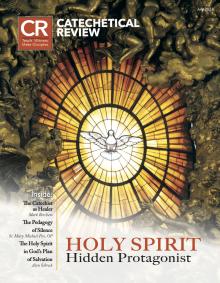“What are those five naked boys doing in my Holy Family?”[1] Thus exclaims Agnolo Doni in Irving Stone’s novel The Agony and the Ecstasy upon seeing the tondo (round painting) he had commissioned from Michelangelo. Whether or not the real Agnolo Doni found the picture surprising in 1509, viewers today may well find the inclusion of such background figures strange.
The presence of five nude youths is not the only puzzling thing about the Doni Tondo. The arrangement of the principal figures is most unusual. Although the Virgin Mary being seated on the ground is a recognized type, known as the “Madonna of Humility,” here she has bare, muscular arms, and her gesture is vigorous, even athletic. St. Joseph sits behind and above Mary—perhaps on a low stool or a rock, but the support remains mysterious—with his knees framing the Virgin. Mary has just lifted Jesus up and is releasing her hold as Joseph firmly grasps the child.
In paintings as in parables, the strange elements can serve as keys to interpretation. The multiple puzzling features of Michelangelo’s tondo, far from discouraging us, guide us in our search for the picture’s meaning.
Why is Joseph seated higher than Mary? Well, he is clearly the head of the family. Perhaps that is all that his position in the painting is meant to suggest. With this thought in mind, let us continue looking.
No other known depiction of the Holy Family shows Mary sitting between Joseph’s knees. Elsewhere in art, this position alludes to a parent-child relationship, as in Masaccio’s Madonna and Child with Saint Anne in the Uffizi Gallery, or Michelangelo’s own Bruges Madonna. Of course, Joseph is not Mary’s father; yet, the arrangement insists on Mary’s role as a daughter. Mary was the daughter of St. Joachim, but nothing in the painting suggests that the man depicted is Joachim rather than Joseph. His bald crown and white beard, and his blue tunic and orange cloak, are all common attributes of St. Joseph in Renaissance art. The puzzle remains. Is there anyone else to whom Mary is a daughter and with whom this figure of Joseph can be associated?
Mary is, through adoption in Christ, a daughter to God. We see St. Joseph, head of the Holy Family and foster father of Jesus, but Michelangelo strongly suggests that, at the same time, we also think of God the Father. In this light, we can find a deeper meaning in the placement of Joseph’s head at the top of the circle. Joseph is the head of the Holy Family, but all paternity takes its name from the fatherhood of God (Eph 3:14–15). Moreover, as the foster father of Jesus, Joseph acts in loco parentis toward the Son of God. Notice that the heads of Jesus and Joseph are on the same level at the summit of the painting, pointing to the fact that Jesus is consubstantial with, and hence equal to, the Father.
The rest of this online article is available for current Guild members.
This article is from The Catechetical Review (Online Edition ISSN 2379-6324) and may be copied for catechetical purposes only. It may not be reprinted in another published work without the permission of The Catechetical Review by contacting [email protected]

















